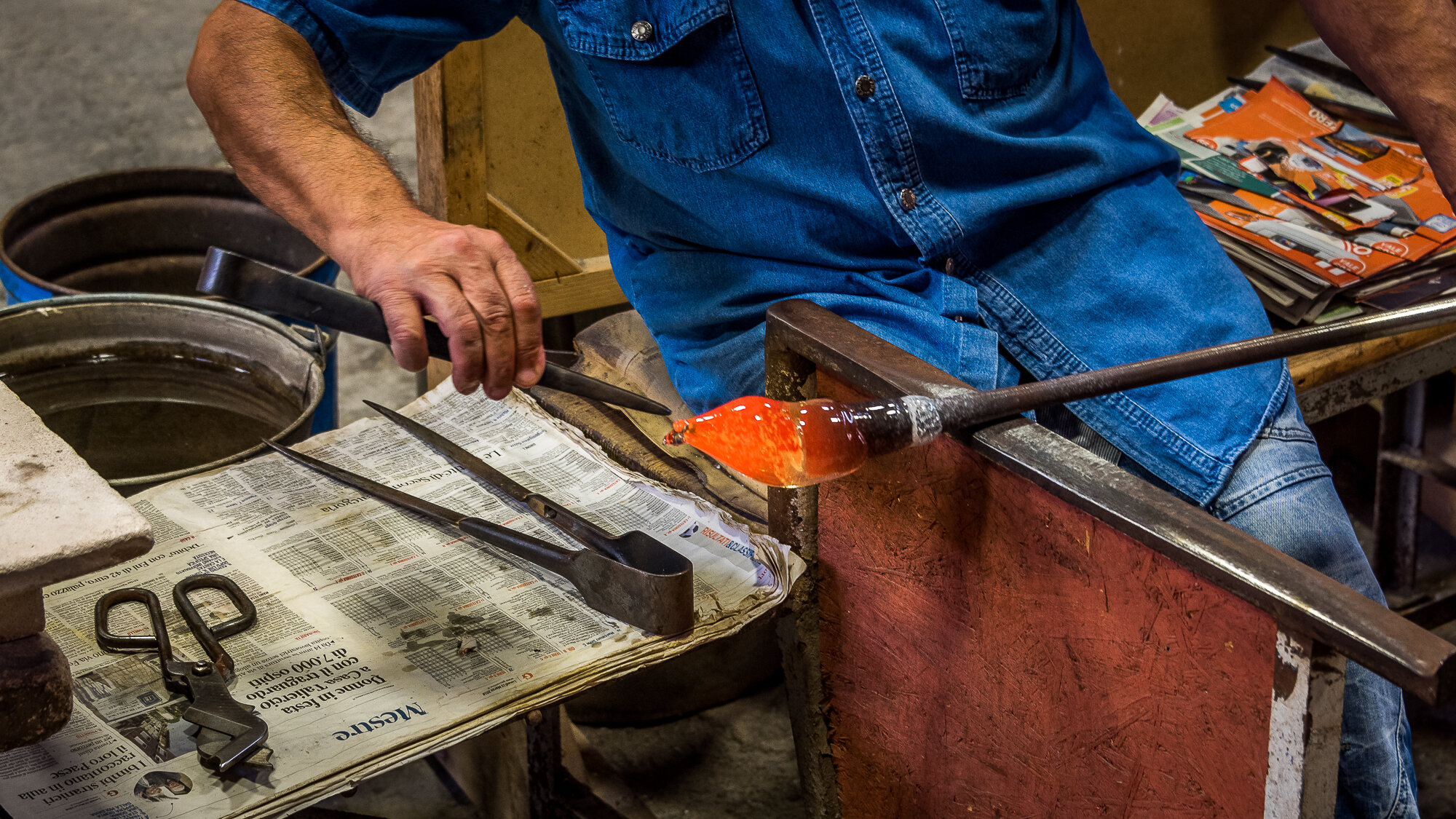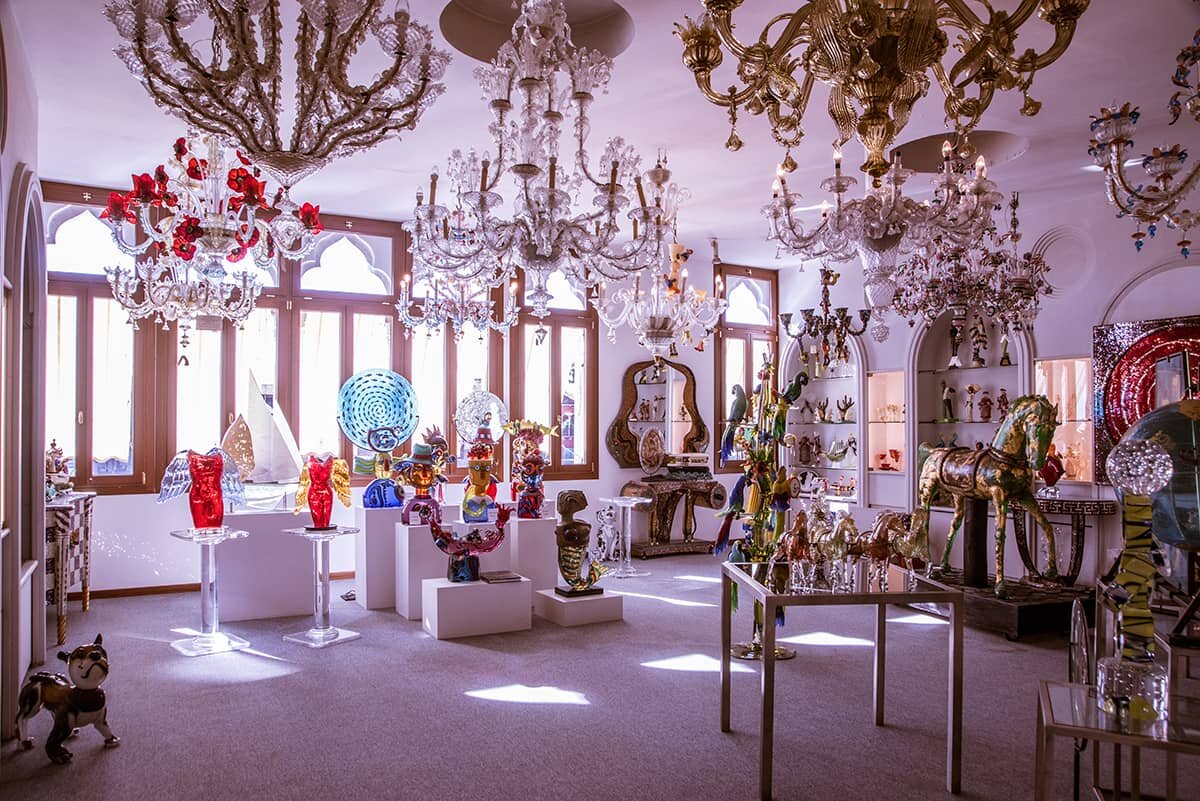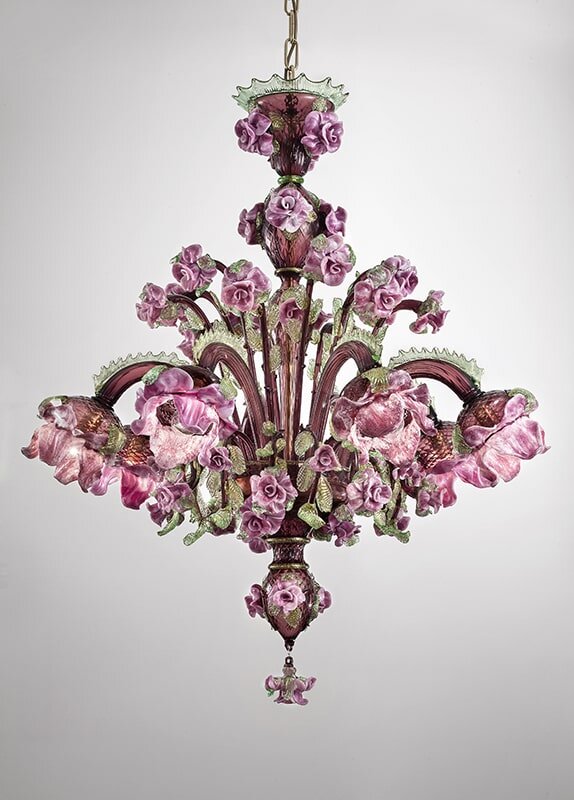“As I explain below, booking a tour has its benefits.”
Today, we visit a typical Murano-island glass ‘fornace’, or glass furnace…in other words, a glass making workshop. Though accompanying photos are from a recent visit to Fornace Estevan Rossetto, the process of visiting any fornace is pretty much the same. So, I’ll just focus on the generic adventure of visiting a Murano glass factory, or fornace. We’ve been to four glass factories/foundries/furnaces/fornaces over the years, and each experience has been mostly the same…and fun…and productive (i.e. we bought something that we treasure).
The Island of Murano
Glass blowing businesses in Venice are located on the island of Murano, not the main conglomerate of islands and canals known as Venice proper. The aerial photo shows the proximity of Murano to Venice. It is about a mile north of Venice, and it is about a mile in diameter.
In between Venice and Murano is the island of San Michele, which is Venice’s cemetery island.
Like Venice proper, Murano is a whole bunch of small islands linked by a lesser number of bridges. So, like the 5,000 inhabitants of Murano, you need to know your way around the labyrinth of bridges and calles to get where you want to be.
Want to venture to Murano? The absolute best way to experience the glass-blowing arts of Murano is to take a tour of one of the many facilities there. And, as I explain below, booking a tour has its benefits.
A Forced Move to the Island of Murano
Glass makers in the populous Venice proper were forced by the Venetian Republic to move to Murano because of the fear of fire. In contrast to today’s Venice, most of Venice’s buildings were wooden in the 13th century. So in 1291, off to the less-populated island of Murano they went.
The move wasn’t such a bad thing for these mobile glass makers. Their prominence soared as they became more important to Venice’s European status. Statutory privileges abounded, as they were immune from prosecution, were able to marry off their daughters to affluent Venetian families…and, they looked really nifty because they were allowed to wear swords when others were denied this privilege.
Though they looked really cool wearing a sword and having certain immunities, there was a trade off. They were physically bound to the Venetian lagoon. They were not allowed to leave for fear that their uniquely perfect glass making techniques would be shared with others. Thus, the monopoly on high quality glass making was protected for centuries…until some were lured away to conduct their trade and share their knowledge…shame on them!
Getting to Your Murano Island Glass-Making Experience
There is only one way to get between islands in the Venetian lagoon…and that’s by boat. But alas, there are many types of boats in the lagoon, as you can see here in my whimsical composite titled, ‘Busy Day on the Grand Canal’.
The most prominent for our own liquid movement opportunities are the vaporetto, gondola, and water taxi. A vaporetto is basically a water bus. It is the most prominent means of travel within Venice, and between the many other islands in the Venetian lagoon. Here are a couple of photos of vaporetti (vaporetti is plural of a vaporetto).
[As usual, you can click on an image to get a larger view]
A vaporetto is ok…and you will probably use one to get around on the Grand Canal and to get to the other islands of Venice. However, it isn’t necessary to take a vaporetto to Murano…but you might need one to get back…keep reading to see what I mean.
How about a gondola? Well, its a long ways out there to Murano (again, about a mile) and the water can get pretty choppy, and I doubt if you could talk a gondolier into making the journey…and do you want them to wait for you? I have seen gondola in choppy waters like these folks are experiencing, but not often.
The water taxi is the ultimate way to get to your glass making experience on Murano. The water taxi are sleek and comfortable. Which of these two boats is a water taxi that you would want to ride to Murano? I’ll let you figure that out!
The taxi drivers (taxiliers?) take great pride in their wooden boats and they keep them pristinely waxed, like this one reflecting a palazzo on the Grand Canal.
Here are friends Debbie and Scott enjoying the beginning of their ride to Murano.
So, how do you wrangle a water taxi ride to and from Murano?
Arranging Your Glass-Making Tour
You could take a ride on your own to Murano without taking a ‘tour’, but I’m not sure how it would go for you. Which of the glass showrooms has a glass master working today? When do you need to arrive to get the full experience? Etc?
Let’s do it this way. You will find Murano glass-making tour hawkers in various parts of Venice…primarily the places where people are most gathered. Maybe the tour is reputable, but then maybe it isn’t. Here’s the best way to arrange for you tour. Use your hotel.
The front desk at your hotel is a great place to start…or the concierge, if there is one. The hotel employees have access to glass-making facilities that they trust…after all, they want your tour to increase your trust of their hotel, not detract from it. So, just ask at the hotel the day before you want to visit Murano. Give them a general time, like morning or afternoon. And be sure to ask whether you will be provided with water taxi transportation, as that’s the whole point of going through your hotel. They will make the appropriate arrangements for you…including the exact time and place you will need to be waiting for your transportation.
Your Glass-Making Adventure
If you’ve followed the advise above, you will be whisked in comfort (no matter the weather) to a glass-making fornace of your hotel’s choice. In our experience, they are pretty much the same.
For our tour of Fornace Estevan Rossetto, you can see in the photo where we arrived…at the dock. The fornace/furnace/glass-blowing-area is at the entrance where the dock terminates into the building. You can see that the whole facility is linear…and we have experienced this at most all of the facilities. You will go from the creation area to the showroom, where you can purchase your glass keepsake.
We were greeted by this lovely young lady…perhaps named Pia…if not, my apologies.
Our first stop is the room containing the fornace. If it is a bit chilly outside, you will be comfortable within the workshop.
We’ve arrived at the beginning of the Master’s production of a vase. Between the 2nd and 3rd photo, he actually blew into the iron pipe to form a round shape, and he subsequently used one of his tools to deftly create the neck of the vase, as seen in the 3rd photo. Then, as if by magic, he removed the vase, flipped it end-for-end, and re-applied it to the pipe. In the 4th photo, you can see that he is now working on the fluted top of the vase. And in the 5th photo, he is crimping the top of the vase as a design element.
In this next series, the Master is working on a mystery piece. He first goes to the furnace where a glob of glass is daubed onto the blow pipe, as seen in the 2nd photo. In photos 3 and 4, he begins to create a still unrecognizable shape. You can see the almost completed horse in the 5th photo. After bending legs this way and that (yes, it is still malleable), and firmly setting the horse down upon a flat surface to be sure that the two hind legs and the tail make a stable setting (no pun intended on the word ‘stable’), we see the finished product, along with its cousin completed just a bit later. In all, it took the Master less than 5 minutes to complete one horse.
I’ve used the term ‘Master’ a few times, and the term is not used lightly. It takes years to become a Master glass craftsman, after creating hundreds of lower-quality touristy pieces as an Apprentice.
Now, to the Showroom
After watching a Master create something right before your eyes, you will be directed to the showroom. Here you can see hundreds of pieces created at the particular fornace. Here are some photos from the Fornace Estevan Rossetto website.
The Masters of Murano are most famous for their chandeliers. And, they are surely most excellent works of art…and they cast nice light within your room, for sure. Here are a few photos of the Fornace Estevan Rossetto Murano-glass chandeliers.
And here are a couple that we had in our bedrooms during our last visit to Italy.
Beautiful! I know, right?
Getting Back to Venice-Proper
Of course, as you know, you can always take a vaporetto back. But, there is a better way. However, this better way can be a bit expensive.
What’s the trick? Buy something in the showroom. I’m not sure exactly how much you have to buy, but we’ve managed a water-taxi ride back each time…well, on the last trip we wanted to eat lunch on Murano after our showroom purchase, so Fornace Estevan Rossetto provided their boat to take us a ways for lunch at Trattoria Busa alla Torre. After lunch, we amble-shopped toward the closest vaporetto stop to return to Venice.
So, what does it take to get a water taxi ride back? Here are some things we have purchased over the years that earned us that ride.
The item in the first photo is 15” across and 12” high. Our salesfriend, Alivesi, suggested that we could use it as a margarita glass! Alivesi had this bowl etched on the bottom with ‘BURKETT Murano 18-9-1997’…he said that this would make it an heirloom! (BTW in Italy when writing out a date in digital format, the day comes before the month) The white-glass chalice or bowl in the 4th photo is one of the most exquisite pieces that we’ve ever seen. The white-on-clear rods had to be built up in two different patterns before all was expertly fused together into this work of art. I’m going to the dining room to gaze at this particular piece……OK, I’m back.
Speaking of Alivesi, here is a humourus anecdote from our trip in 1997.
During the 1997 trip to Murano, our friends Mike and Judy Ponsford were with us. We had a morning tour of one of the fornace, starting about 10am. After visiting the workshop, we entered the showroom. When Alivesi recognized that we were going to be purchasers rather than just lookers, he brought out his most effective negotiation tool…a bottle of nice red wine. Who cared that it was now about 10:45am? Not us! Mike and Judy had picked out about a dozen items for consideration. Mike would put a few items in a cluster and ask, “How much?”. He repeated this a half-dozen times with different clusters. He finally reached around the whole grouping of items and quoted a price with which he would be comfortable. Alivesi was taken aback a bit and suggested that, “Signore Ponsford, your arms are much too long!”. To complete the story, after payment and providing shipping information (don’t try to pack your purchase in your luggage), we went out onto the dock to await our water taxi ride back into Venice. Alivesi came out onto the dock to let us know that the boat would be here in about 10 minutes, and then he asked, “Would you like red or white while you wait?”…we opted for another round of red! This was a truly fun adventure to the island of Murano.
I hope you enjoyed our tour to a fine-glass producing fornace. If it isn’t absolutely clear to you how to arrange for and get out to your tour, I would be happy to make the arrangements when we are there together…we enjoy every visit to Murano!
Ciao for now,
Steve
Not already a subscriber to this blog? Click here to resolve that issue







































